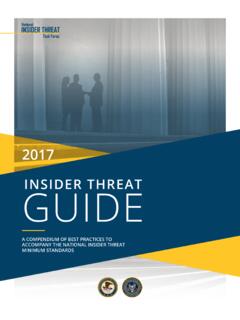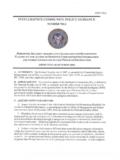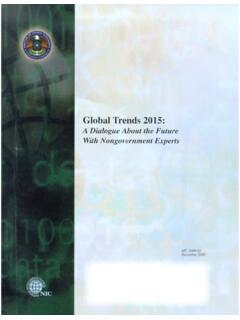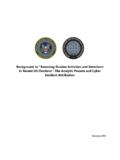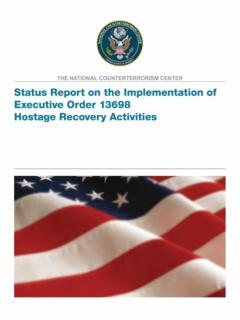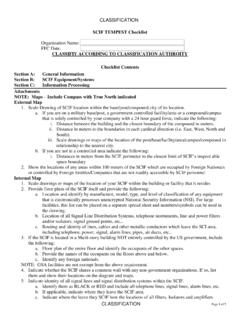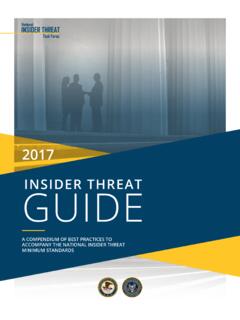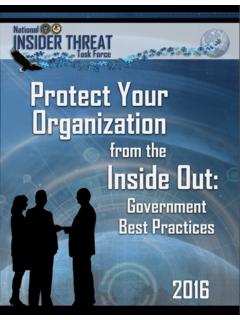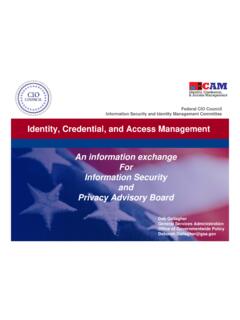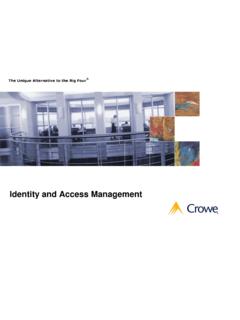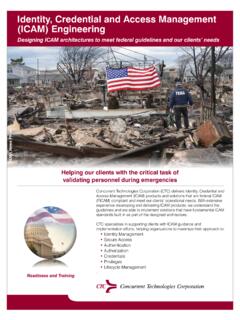Transcription of Table of Contents - dni.gov
1 identity , Credential and access Management (ICAM) for First Responders, National Strategy Summit: Recommended Principles and Actions Table of Contents ACKNOWLEDGEMENTS .. i BACKGROUND .. 1 DOCUMENT PURPOSE .. 2 RECOMMENDED PRINCIPLES .. 3 I. FEDERATED ICAM STRATEGY .. 3 AND LAYERING OF POLICIES .. DECENTRALIZED CREDENTIALING WITH DELEGATION .. OF STANDARDS .. 6V. LEVERAGE WHAT EXISTS .. 7 FEASIBILITY .. 8 VII. EASE OF USE FOR PRACTITIONERS .. 9 VIII. AFFORDABILITY AND SUSTAINABILITY .. AND AGILITY .. 10X. IMPORTANCE OF GOVERNANCE .. 10 RECOMMENDED ACTIONS AND NEXT STEPS .. 11 I. ADOPT PRINCIPLES AND FACTOR INTO IMPLEMENTATION.
2 11 ROLE OF ICAM SUMMIT PARTICIPANTS .. A ROADMAP .. FIRSTNET access REQUIREMENTS .. 11V. TEST CANDIDATE SOLUTIONS .. 11 SERVICE PROVIDERS TO MODULARIZE THEIR SECURITY POLICIES .. 12 APPENDIX A TERMINOLOGY .. 13 APPENDIX B NATIONAL STRATEGY SUMMIT: identity , CREDENTIAL, AND access MANAGEMENT (ICAM) DEVELOPING A NATIONAL STRATEGY FOR WIRELESS MOBILITY IN LAW ENFORCEMENT, JUSTICE, AND PUBLIC SAFETY .. 15 APPENDIX C ATTENDEE ROSTER .. 19 APPENDIX D AGENDA .. 25 APPENDIX E USE CASES .. 30 APPENDIX F BRIEFING SHEETS .. 36 APPENDIX G ISE BROCHURE: INTRODUCTION TO ICAM PRINCIPLES identity , CREDENTIAL, AND access MANAGEMENT.
3 64 i Acknowledgements In the explosion of technology supporting public mobility and ubiquitous connectivity, law enforcement, justice, and public safety agencies have been left behind: great difficulty still exists in making the connection to the last mile .. the police officer, deputy sheriff, firefighter, and paramedic in a vehicle or in the field. These professionals our colleagues need immediate access to critical information from the wide variety of systems technology available (particularly portable computers, tablets, and smartphones) to make the best possible decisions and protect themselves and the public.
4 Hand in hand with access challenges is the imperative to ensure robust internal controls on security, including factoring in today s Bring Your Own Device (BYOD) environment. Resolution of these access and security issues has been a long-standing challenge and high-priority need. With support from the Program Manager for the Information Sharing Environment, the Department of Homeland Security, and the International Association of Chiefs of Police, a planning committee was formed to advance the nation s wireless mobility capabilities through a collaborative event. In early October 2014, we convened justice and public safety leaders and communications subject-matter experts from across the associated communities at the National Strategy Summit ( Summit ) on identity , Credential, and access Management (ICAM) Developing a National Strategy for Wireless Mobility in Law Enforcement, Justice, and Public Safety.
5 Each invitee was chosen not only to represent a specific organization, sector, or constituency, but also based on his or her individual skillset and professional background, with an eye toward carefully balancing viewpoints and equities at the Summit Table . (See Appendix C for the Summit roster.) As Planning Committee cochairs, we want to express our sincere appreciation to members of this impressive team for their efforts throughout the Summit process: from digesting the preparatory materials; to vigorous on-site engagement and exchanges of viewpoints and experiences; to thoughtfully revising and significantly strengthening this document.
6 The following Recommended Principles and Actions Report is a direct reflection of the participants willingness to capitalize on the Summit opportunity, partnering, and contributing a wide range of expertise toward a common goal and greater good. We also want to thank the Bureau of Alcohol, Tobacco, Firearms and Explosives (ATF), Department of Justice, for hosting the Summit in Washington, DC. Fundamental to the October discussions was the understanding that successful development of and cross-disciplinary support for a national ICAM approach is essential to widespread adoption of wireless mobility in the law enforcement, fire service, emergency medical service, and justice communities, and is ultimately fundamental to the safety of our colleagues and communities.
7 We believe the Summit results and recommendations are a significant next step towards these goals. ICAM Summit Planning Committee Cochairs Mr. Kshemendra Paul, Program Manager for the Information Sharing Environment Mr. Daniel Cotter, Director, Office for Interoperability and Compatibility, Department of Homeland Security Chief Harlin R. McEwen, Chairman, Communications and Technology Committee, International Association of Chiefs of Police identity , Credential and access Management (ICAM) for First Responders, National Strategy Summit: Recommended Principles and Actions 1 Background The First Responder Network Authority (FirstNet) is an independent authority within the National Telecommunications and Information Administration, established by Public Law 112 96 on February 22, 2012.
8 FirstNet is charged with implementing a single Nationwide Public Safety Broadband Network (NPSBN), a wireless broadband data-sharing network primarily for public safety personnel. The FirstNet NPSBN will be different from current commercial wireless networks, as it is dedicated to public safety. With the implementation of the FirstNet NPSBN comes an opportunity for law enforcement and public safety entities to take advantage of a more reliable network. With this opportunity comes the challenge of protecting the integrity and security of the network and the privacy and confidentiality of the data that is accessed.
9 This network will enable public safety agencies nationwide to exchange information across jurisdictional and disciplinary boundaries, from virtually any location, using a wide variety of mobile devices. Achieving this mission will require FirstNet to develop strategies, standards, and conventions in many areas, in order to ensure interoperability, security, and efficient operation of the network. One such area addresses the registration, verification, authentication, and authorization of a public safety official or other approved individual to have proper access to the NPSBN, both initially and on an ongoing basis as officials roles, agency associations, levels of training and certification, and employment status change over time.
10 This area of concern is commonly called identity , Credential, and access Management (ICAM). On October 8-9, 2014, 60 public safety and ICAM subject matter experts1 convened at the Bureau of Alcohol, Tobacco, Firearms and Explosives headquarters in Washington, DC for the ICAM National Strategy The objective of the Summit was to gain a consensus around principles and actions that will inform a strategy for identifying and managing authorized users of the FirstNet NPSBN. While the Summit focused primarily on an ICAM strategy for FirstNet, there was recognition that the principles underlying this strategy and, in fact, the strategy itself should be leveraged by other initiatives needing to secure access to resources by understanding the identity and characteristics of the users needing to access those resources.
